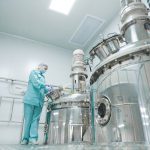The air-lift fermenter is a type of bioreactor used in the fermentation process to cultivate microorganisms under aerobic conditions. It operates based on the principle of gas-lift circulation, which provides a gentle and efficient mixing of the fermentation broth. The air-lift fermenter is particularly suitable for aerobic microbial cultures and is commonly used in various biotechnological applications for the production of enzymes, proteins, biofuels, and other bioproducts.
Here’s how an air-lift fermenter typically works:
- Reactor Structure: The air-lift fermenter consists of a vertical cylindrical vessel with two main sections – the riser and the downcomer. The riser is the taller section where the aeration and mixing occur, and the downcomer is a shorter section where the liquid phase flows downward.
- Aeration: Compressed air or another oxygen-containing gas is introduced at the bottom of the riser through a sparger or diffuser. As the gas rises through the riser, it creates a two-phase flow by entraining the liquid medium with it. This gas-liquid flow provides mixing and circulation of the fermentation broth.
- Circulation: The rising gas bubbles create a buoyant force that lifts the liquid upward in the riser. As the liquid reaches the top, it overflows into the downcomer section. Gravity then drives the liquid downward through the downcomer due to the hydrostatic head difference between the two sections.
- Mixing and Oxygen Transfer: As the liquid moves down the downcomer, it is exposed to the rising gas bubbles from the riser. This continuous gas-liquid contact enhances mixing and facilitates oxygen transfer to the microorganisms present in the liquid. The oxygen is crucial for supporting aerobic respiration and promoting the growth of aerobic microorganisms.
- Outlet and Recirculation: At the bottom of the downcomer, the liquid is collected and recirculated back to the bottom of the riser. This recirculation helps maintain the continuous flow of the fermentation broth through the system and ensures uniform conditions for microbial growth.
Advantages of Air-Lift Fermenters:
- Gentle Mixing: The gentle and non-mechanical mixing provided by the gas-lift circulation reduces the shear stress on fragile microorganisms, making it suitable for sensitive cultures.
- Enhanced Oxygen Transfer: The continuous aeration and gas-liquid contact result in efficient oxygen transfer, supporting aerobic microbial growth and improving fermentation efficiency.
- Scalability: Air-lift fermenters can be easily scaled up for large-scale production without significant engineering challenges.
Applications of Air-Lift Fermenters:
- Production of microbial biomass and metabolites, such as enzymes and proteins
- Fermentation of aerobic microorganisms for biofuel production, such as ethanol or butanol
- Cultivation of aerobic cell lines for biopharmaceuticals
Air-lift fermenters are favored for their advantages in aerobic fermentation processes. However, for certain anaerobic processes or applications requiring higher mixing intensity, other types of bioreactors, such as stirred-tank fermenters or anaerobic digesters, may be more appropriate.

Leave a Reply